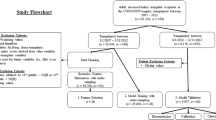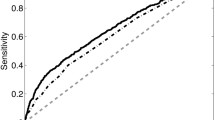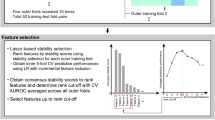Abstract
Objective
We aimed to develop a risk prediction model using a machine learning to predict survival and graft failure (GF) 5 years after orthotopic heart transplant (OHT).
Methods
Using the International Society of Heart and Lung Transplant (ISHLT) registry data, we analyzed 15,236 patients who underwent OHT from January 2005 to December 2009. 342 variables were extracted and used to develop a risk prediction model utilizing a gradient-boosted machine (GBM) model to predict the risk of GF and mortality 5 years after hospital discharge. After excluding variables missing at least 50% of the observations and variables with near zero variance, 87 variables were included in the GBM model. Ten fold cross-validation repeated 5 times was used to estimate the model’s external performance and optimize the hyperparameters simultaneously. Area under the receiver operator characteristic curve (AUC) for the GBM model was calculated for survival and GF 5 years post-OHT.
Results
The median duration of follow-up was 5 years. The mortality and GF 5 years post-OHT were 27.3% (n = 4161) and 28.1% (n = 4276), respectively. The AUC to predict 5-year mortality and GF is 0.717 (95% CI 0.696–0.737) and 0.716 (95% CI 0.696–0.736), respectively. Length of stay, recipient and donor age, recipient and donor body mass index, and ischemic time had the highest relative influence in predicting 5-year mortality and graft failure.
Conclusion
The GBM model has a good accuracy to predict 5-year mortality and graft failure post-OHT.


Similar content being viewed by others
References
Wilhelm MJ. Long-term outcome following heart transplantation: current perspective. J Thorac Dis. 2015;7(3):549–51.
Chambers DC, Yusen RD, Cherikh WS, Goldfarb SB, Kucheryavaya AY, Khusch K, et al. The registry of the International Society for Heart and Lung Transplantation: thirty-fourth adult lung and heart-lung transplantation report—2017; focus theme: allograft ischemic time. J Heart Lung Transplant. 2017;36(10):1047–59.
Fayek S, Quintini C, Chavin K, Marsh C. The current state of liver transplantation in the United States: perspective from American Society of Transplant Surgeons (ASTS) Scientific Studies Committee and endorsed by ASTS Council. Am J Transplant. 2016;16(11):3093–104.
United Network for Organ Sharing. Facts about transplantation in the United States. Richmond, VA: UNOS. 1992;1:42.
Lund LH, Edwards LB, Kucheryavaya AY, Benden C, Dipchand AI, Goldfarb S, et al. The Registry of the International Society for Heart and Lung Transplantation: thirty-second official adult heart transplantation report–2015; focus theme: early graft failure. J Heart Lung Transplant. 2015;34(10):1244–54.
Weiss ES, Allen JG, Arnaoutakis GJ, George TJ, Russell SD, Shah AS, et al. Creation of a quantitative recipient risk index for mortality prediction after cardiac transplantation (IMPACT). Ann Thorac Surg. 2011;92(3):914–21.
Nilsson J, Ohlsson M, Höglund P, Ekmehag B, Koul B, Andersson B. The International Heart Transplant Survival Algorithm (IHTSA): a new model to improve organ sharing and survival. PLoS ONE. 2015;10(3):e0118644.
Cruz JA, Wishart DS. Applications of machine learning in cancer prediction and prognosis. Cancer Inform. 2007;2:59–77.
Friedman J. Stochastic gradient boosting. Department of Statistics. San Francisco: Stanford University, Technical Report; 1999.
Friedman J. Greedy function approximation: a gradient boosting machine. Ann Stat. 2001;29:1189–232.
Kuhn M. Building predictive models in R using the caret package. J Stat Softw. 2008;28:1–26.
Greenwell B, Boehmke B, Cunningham J, Developers G (2018) Generalized Boosted Regression Models. R Package Version 21. 4.
DeLong ER, DeLong DM, Clarke-Pearson DL. Comparing the areas under two or more correlated receiver operating characteristic curves: a nonparametric approach. Biometrics. 1988;44:837–45.
Robin X, Turck N, Hainard A, et al. pROC: an open-source package for R and S+ to analyze and compare ROC curves. BMC Bioinformatics. 2011;12:77.
Weiss ES, Allen JG, Kilic A, Russell SD, Baumgartner WA, Conte JV, et al. Development of a quantitative donor risk index to predict short-term mortality in orthotopic heart transplantation. J Heart Lung Transplant. 2012;31(3):266–73.
Smits JM, De Pauw M, de Vries E, Rahmel A, Meiser B, Laufer G, et al. Donor scoring system for heart transplantation and the impact on patient survival. J Heart Lung Transplant. 2012;31(4):387–97.
Hong KN, Iribarne A, Worku B, Takayama H, Gelijns AC, Naka Y, et al. Who is the high-risk recipient? Predicting mortality after heart transplant using pretransplant donor and recipient risk factors. Ann Thorac Surg. 2011;92(2):520–7.
Anyanwu AC, Rogers CA, Murday AJ. A simple approach to risk stratification in adult heart transplantation. Eur J Cardiothorac Surg. 1999;16(4):424–8.
Biganzoli E, Boracchi P, Mariani L, Marubini E. Feed forward neural networks for the analysis of censored survival data: a partial logistic regression approach. Stat Med. 1998;17(10):1169–86.
Lippmann RP, Shahian DM. Coronary artery bypass risk prediction using neural networks. Ann Thorac Surg. 1997;63(6):1635–43.
Pedotti P, Mattucci DA, Gabbrielli F, Venettoni S, Costa AN, Taioli E. Analysis of the complex effect of donor’s age on survival of subjects who underwent heart transplantation. Transplantation. 2005;80(8):1026–32.
Russo MJ, Chen JM, Sorabella RA, Martens TP, Garrido M, Davies RR, et al. The effect of ischemic time on survival after heart transplantation varies by donor age: an analysis of the United Network for Organ Sharing database. J Thorac Cardiovasc Surg. 2007;133(2):554–9.
Russo MJ, Iribarne A, Hong KN, Ramlawi B, Chen JM, Takayama H, et al. Factors associated with primary graft failure after heart transplantation. Transplantation. 2010;90(4):444–50.
Kilic A, Weiss ES, George TJ, Arnaoutakis GJ, Yuh DD, Shah AS, et al. What predicts long-term survival after heart transplantation? An analysis of 9,400 ten-year survivors. Ann Thorac Surg. 2012;93(3):699–704.
Reichart B. Size matching in heart transplantation. J Heart Lung Transplant. 1992;11(4 Pt 2):S199–202.
Zeier M, Döhler B, Opelz G, Ritz E. The effect of donor gender on graft survival. J Am Soc Nephrol. 2002;13(10):2570–6.
Funding
No funding was available for the current study.
Author information
Authors and Affiliations
Contributions
PA designed the study, extracted the data, drafted the initial manuscript, and critically reviewed the manuscript. SDS drafted the initial manuscript and critically reviewed the manuscript. SA extracted the data and critically reviewed the manuscript. MB analyzed the data, prepared the figures, and critically reviewed the manuscript. MAG analyzed the data, prepared the figures, and critically reviewed the manuscript. JLR critically reviewed the manuscript. BWH critically reviewed the manuscript. PD critically reviewed the manuscript. FM designed the study and critically reviewed the manuscript. RA designed the study and critically reviewed the manuscript. All authors have read and approved the final manuscript.
Corresponding author
Ethics declarations
Conflict of interest
The authors have no conflict of interest to declare.
Ethical approval
The study complied with the Declaration of Helsinki and was approved by the local institutional review board. The committee waived the requirement for informed consent in consideration of the retrospective nature of the study and anonymous data analyses.
Additional information
Publisher's Note
Springer Nature remains neutral with regard to jurisdictional claims in published maps and institutional affiliations.
Electronic supplementary material
Below is the link to the electronic supplementary material.
Rights and permissions
About this article
Cite this article
Agasthi, P., Buras, M.R., Smith, S.D. et al. Machine learning helps predict long-term mortality and graft failure in patients undergoing heart transplant. Gen Thorac Cardiovasc Surg 68, 1369–1376 (2020). https://doi.org/10.1007/s11748-020-01375-6
Received:
Accepted:
Published:
Issue Date:
DOI: https://doi.org/10.1007/s11748-020-01375-6




